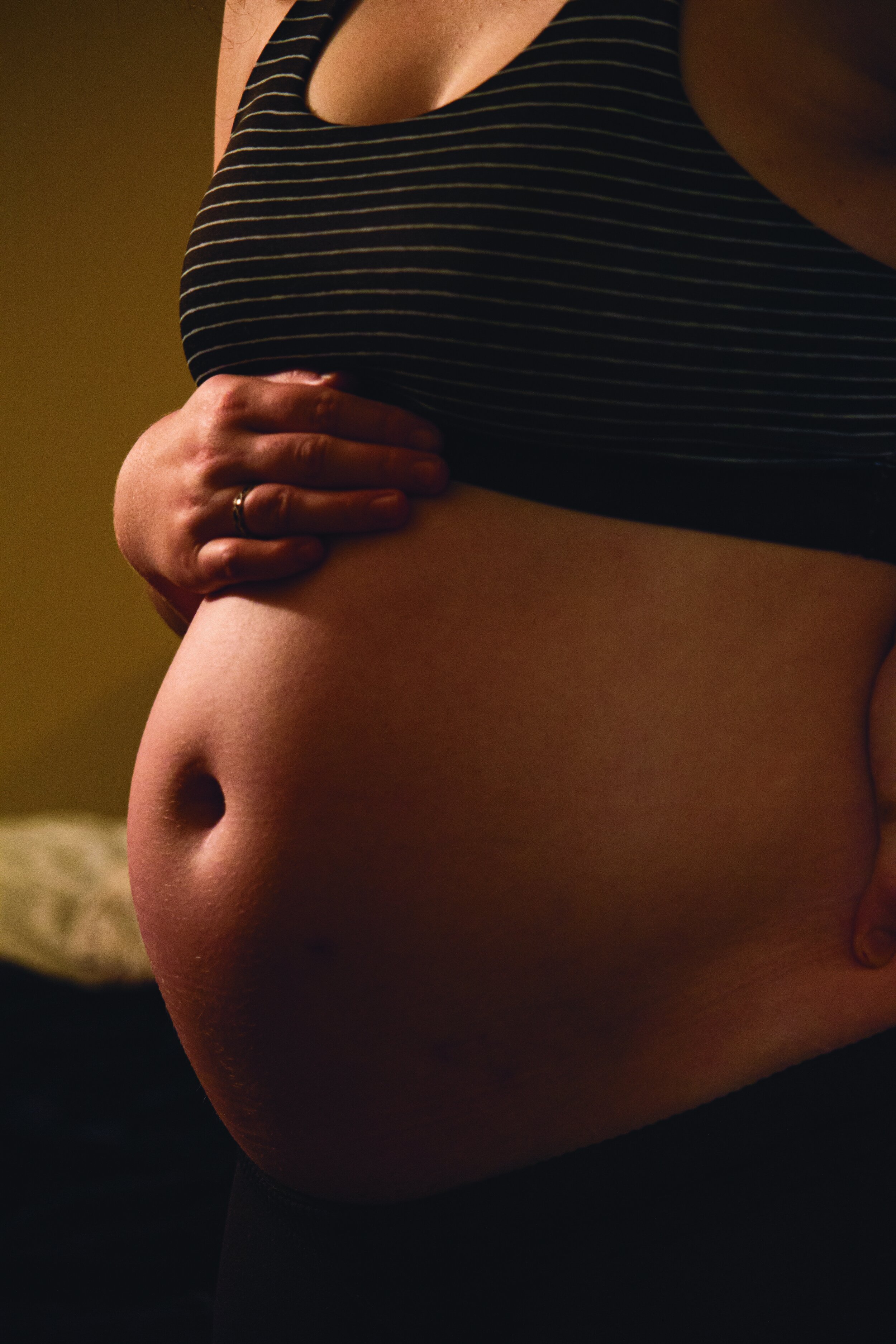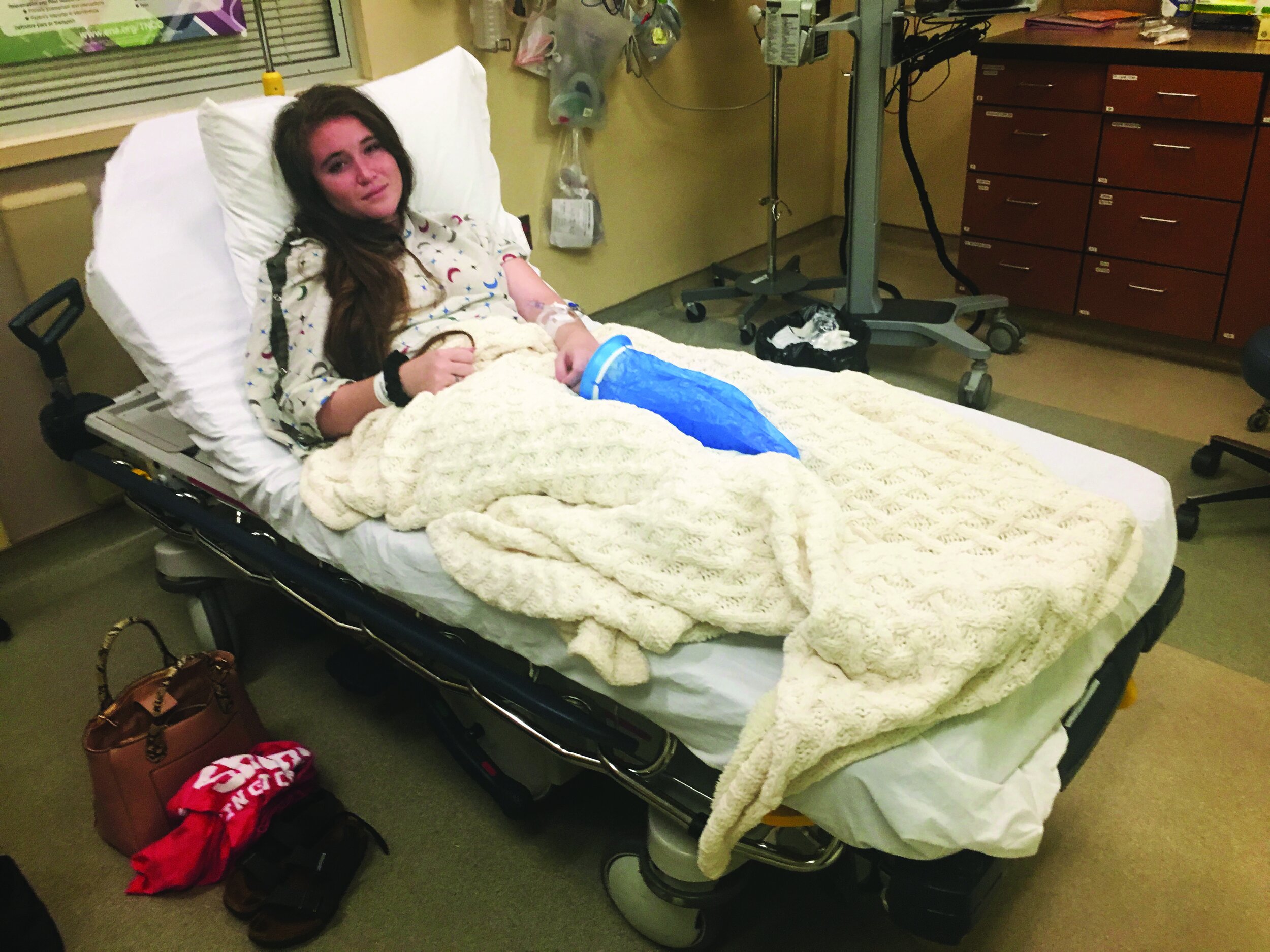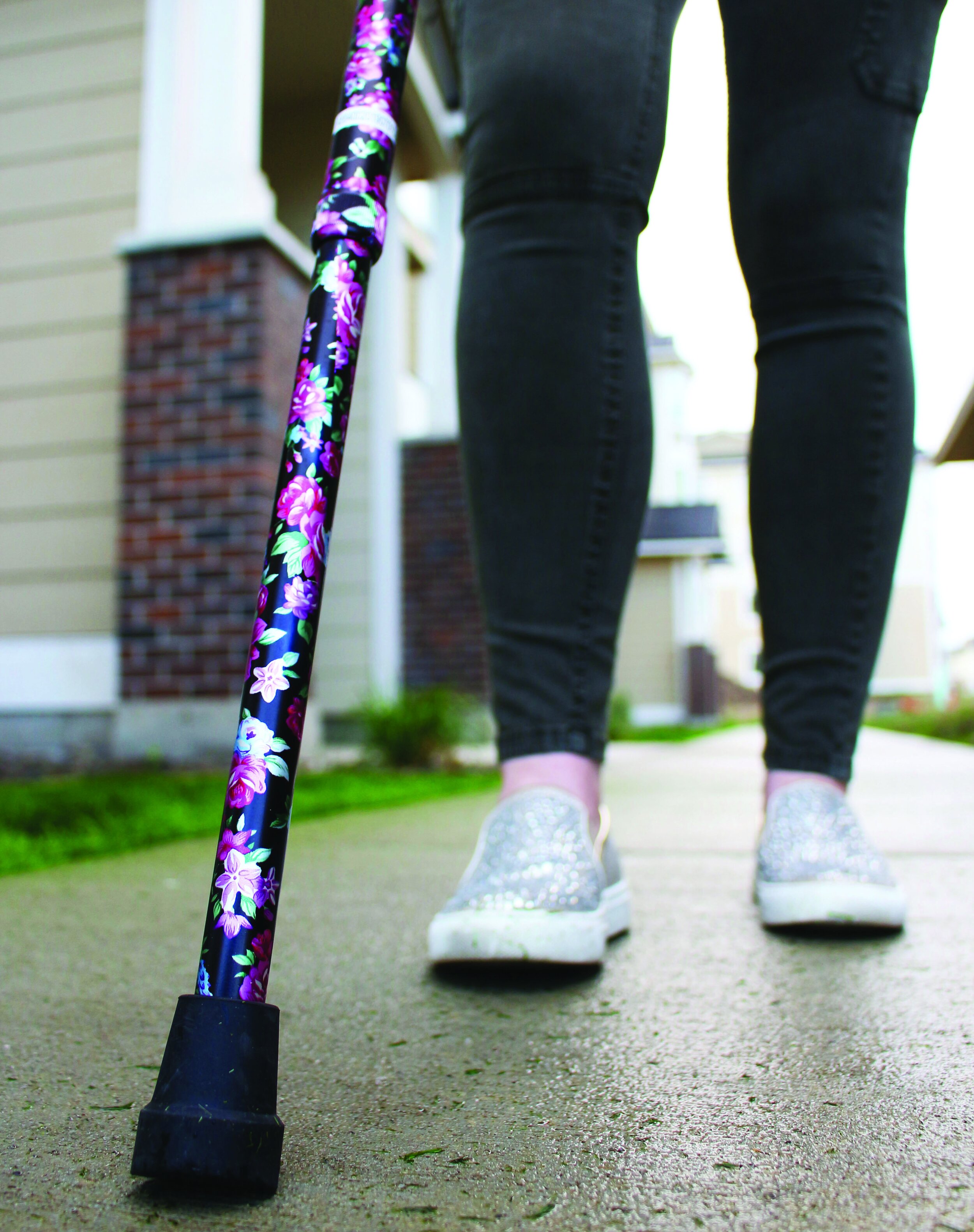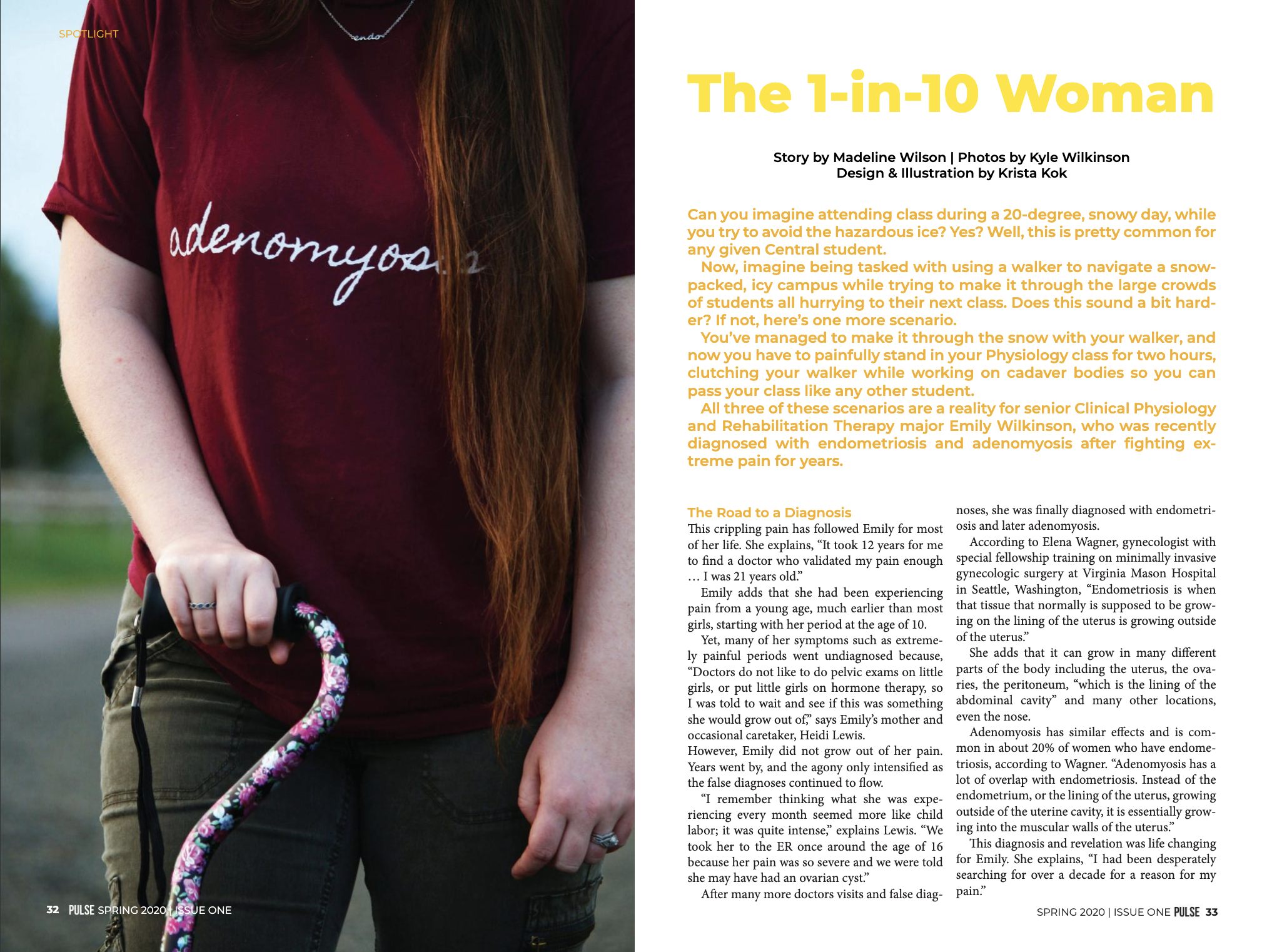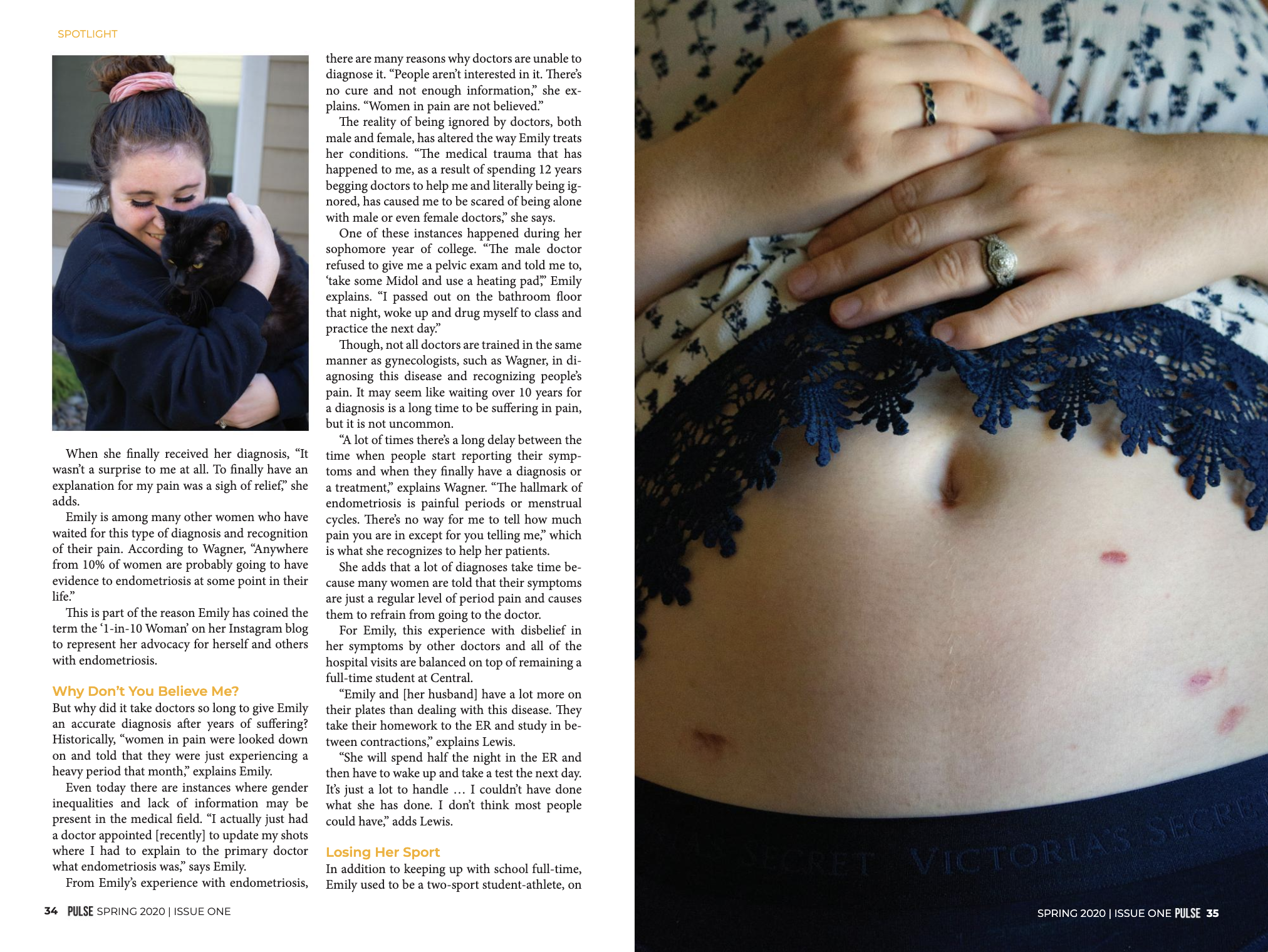The 1-in-10 Woman
Story by Madeline Wilson | Photos by Kyle Wilkinson | Design & Illustration by Krista Kok
Can you imagine attending class during a 20-degree, snowy day, while you try to avoid the hazardous ice? Yes? Well, this is pretty common for any given Central student.
Now, imagine being tasked with using a walker to navigate a snow-packed, icy campus while trying to make it through the large crowds of students all hurrying to their next class. Does this sound a bit harder? If not, here’s one more scenario.
You’ve managed to make it through the snow with your walker, and now you have to painfully stand in your Physiology class for two hours, clutching your walker while working on cadaver bodies so you can pass your class like any other student.
All three of these scenarios are a reality for senior Clinical Physiology and Rehabilitation Therapy major Emily Wilkinson, who was recently diagnosed with endometriosis and adenomyosis after fighting extreme pain for years.
The Road to a Diagnosis
This crippling pain has followed Emily for most of her life. She explains, “It took 12 years for me to find a doctor who validated my pain enough … I was 21-years-old.”
Emily adds that she had been experiencing pain from a young age, much earlier than most girls, starting with her period at the age of 10.
Yet, many of her symptoms such as extremely painful periods went undiagnosed because, “Doctors do not like to do pelvic exams on little girls, or put little girls on hormone therapy, so I was told to wait and see if this was something she would grow out of,” says Emily’s mother and occasional caretaker, Heidi Lewis.
However, Emily did not grow out of her pain. Years went by, and the agony only intensified as the false diagnoses continued to flow.
“I remember thinking what she was experiencing every month seemed more like child labor; it was quite intense,” explains Lewis. “We took her to the ER once around the age of 16 because her pain was so severe and we were told she may have had an ovarian cyst.”
After many more doctors visits and false diagnoses, she was finally diagnosed with endometriosis and later adenomyosis.
According to Elena Wagner, gynecologist with special fellowship training on minimally invasive gynecologic surgery at Virginia Mason Hospital in Seattle, Washington, “Endometriosis is when that tissue that normally is supposed to be growing on the lining of the uterus is growing outside of the uterus.”
She adds that it can grow in many different parts of the body including the uterus, the ovaries, the peritoneum, “which is the lining of the abdominal cavity” and many other locations — even the nose.
Adenomyosis has similar effects and is common in about 20% of women who have endometriosis, according to Wagner. “Adenomyosis has a lot of overlap with endometriosis. Instead of the endometrium, or the lining of the uterus, growing outside of the uterine cavity, it is essentially growing into the muscular walls of the uterus.”
This diagnosis and revelation was life changing for Emily. She explains, “I had been desperately searching for over a decade for a reason for my pain.”
When she finally received her diagnosis, “It wasn’t a surprise to me at all. To finally have an explanation for my pain was a sigh of relief,” she adds.
Emily is among many other women who have waited for this type of diagnosis and recognition of their pain. According to Wagner, “Anywhere from 10% of women are probably going to have evidence to endometriosis at some point in their life.”
This is part of the reason Emily has coined the term the ‘1-in-10 Woman’ on her Instagram blog to represent her advocacy for herself and others with endometriosis.
Why Don’t You Believe Me?
But why did it take doctors so long to give Emily an accurate diagnosis after years of suffering? Historically, “Women in pain were looked down on and told that they were just experiencing a heavy period that month,” explains Emily.
Even today there are instances where gender inequalities and lack of information may be present in the medical field. “I actually just had a doctor appointed [recently] to update my shots where I had to explain to the primary doctor what endometriosis was,” says Emily.
From Emily’s experience with endometriosis, there are many reasons why doctors are unable to diagnose it. “People aren’t interested in it. There’s no cure and not enough information,” she explains. “Women in pain are not believed.”
The reality of being ignored by doctors, both male and female, has altered the way Emily treats her conditions. “The medical trauma that has happened to me, as a result of spending 12 years begging doctors to help me and literally being ignored, has caused me to be scared of being alone with male or even female doctors,” she says.
One of these instances happened during her sophomore year of college. “The male doctor refused to give me a pelvic exam and told me to, ‘take some Midol and use a heating pad’,” Emily explains. “I passed out on the bathroom floor that night, woke up and drug myself to class and practice the next day.”
Though, not all doctors are trained in the same manner as gynecologists, such as Wagner, in diagnosing this disease and recognizing people’s pain. It may seem like waiting over 10 years for a diagnosis is a long time to be suffering in pain, but it is not uncommon.
“A lot of times there’s a long delay between the time when people start reporting their symptoms and when they finally have a diagnosis or a treatment,” explains Wagner. “The hallmark of endometriosis is painful periods or menstrual cycles. There’s no way for me to tell how much pain you are in except for you telling me,” which is what she recognizes to help her patients.
She adds that a lot of diagnoses take time because many women are told that their symptoms are just a regular level of period pain and causes them to refrain from going to the doctor.
For Emily, this experience with disbelief in her symptoms by other doctors and all of the hospital visits are balanced on top of remaining a full-time student at Central.
“Emily and [her husband] have a lot more on their plates than dealing with this disease. They take their homework to the ER and study in between contractions,” explains Lewis.
“She will spend half the night in the ER and then have to wake up and take a test the next day. It’s just a lot to handle … I couldn’t have done what she has done. I don’t think most people could have,” adds Lewis.
Losing Her Sport
In addition to keeping up with school full-time, Emily used to be a two-sport student-athlete, on both the Track & Field and Cross Country teams for Central.
“When she let me know this past fall that there were other health complications really beginning to dominate her life, it was heartbreaking,” explains Head Coach for the Men’s and Women’s Cross Country and Track & Field Teams, Kevin Adkisson.
However, Adkisson was very familiar with Emily’s diagnosis due to his own experiences. He says, “My wife went through many years of painful, frustrating health issues before getting her diagnosis of endometriosis and subsequent treatment.”
“To have a fairly good understanding of what she was experiencing made the situation all the more real, and certainly helped me to give her as much understanding and support as possible as she moved through the process of getting into treatment,” Adkisson adds.
She not only forcibly lost her ability to physically run at a competitive level, but her mental passion for her sport. “I watched her go into a minor depression because of her inability to run and workout like she used to. Running was her therapy, her outlet,” explains Kyle Wilkinson, Emily’s husband, senior Digital Journalism major and PULSE reporter.
However, running is not something that she will have to give up forever. “The nice thing about running is that it can be something to do for a lifetime,” says Adkisson. “She loves running, and being able to put it aside for a while with the knowledge that it would be there for her down the road was a real comfort.”
And she has done exactly that. According to Kyle, she has begun running as much as her body allows on a regular basis, though difficult as she still regularly relies on a cane and walker for support.
Understanding the Pain
Now that you know a bit of backstory about Emily’s road to present day, it’s time to unpack exactly how painful her conditions are, many of which are the cause for her use of a walker.
Unless one has felt this type of pain for themselves, it can be difficult to describe and fully understand.
Emily expresses, “The pain is so high it crushes me; it’s an out-of-body experience. I shattered my shoulder in a boating accident a couple years ago and the pain didn’t even come close to what I feel during an endo attack.”
Emily further explains that another one of the more common symptoms she experiences is false labor on a weekly basis.
“Endometriosis and adenomyosis cause false labor. Imagine going through labor without medical help and medication,” she says. “Adenomyosis causes the exact same graded contractions as someone in labor.”
However, one of the hardest times for her, both physically and mentally, was during the beginning of this year — her senior year of college.
She explains that during this time she was able to see a new doctor who wanted to do laparoscopic surgery, which both she and Kyle agreed was the right decision. “The gold standard diagnosis is through laparoscopy, looking at the abdominal cavity,” says Wagner.
Prior to surgery, she expressed how nervous she was, fearing results wouldn’t yield the answers she desired due to her long, frustrating history with wrong diagnoses.
But after the surgery she says, “We learned that the disease endometriosis was found on my nerves, ureter and ligaments [and] my fallopian tubes had completely collapsed.” The diagnosis was serious, but she now had more answers than before.
After this instance, her pain continued to progress. Emily explains, “My symptoms were so bad that I couldn’t walk across campus to class and was going to school on narcotics and nerve blockers everyday. I would go [to] the hospital and study for exams on a morphine drip.”
Marital Changes
In addition to Emily’s personal struggles with her painful conditions, those who have had to watch her suffer through this pain have experienced their own range of difficulties.
“We’ve spent a lot of time in the emergency room and in hospitals. We’ve both missed school and work because of it,” says Kyle. “There were some days that I would have to call out from work 15 minutes before my shift because we had to go to the ER.”
“I sometimes feel that I cannot go out and do things because I feel responsible for her,” says Kyle. “It’s not that I’m trying to get away from her. I just feel that if I go do something for a day, something bad could happen and I would not be there for her.”
This fear of abandoning his wife during a time of need is what has altered some aspects of how Kyle lives his life. “I feel powerless,” he says. “I feel that I have a responsibility to take care of Emily. She is my wife, life partner and best friend.”
Not only has Kyle been there for Emily since they began dating at 17, he was also right by her side when they found out she was infertile two months into their marriage, according to Emily.
She explains, “Knowing that I didn’t get a choice was really tough for me. I want a family because I know how much my husband wants to be a dad. That’s all Kyle talks about and I know it’s been harder on him than he lets on.”
But Kyle says that this has not affected his outlook on their relationship. He explains, “After being diagnosed with endometriosis and after her first surgery, we adopted our first child, Eli. Emily was able to qualify for a Service Animal certification and we were able to adopt a cat from the local animal shelter.”
He adds, “I think that Eli has been a necessary addition to our family. He filled that void in the family where there was just something missing.”
Kyle and Emily have remained strong for each other throughout the whole process and continue to work together as a team.
Looking to the Future
Endometriosis is not completely curable but there are many options for women like Emily, with this illness.
“There are some people who never need surgery. There are some who go in to have surgery and are subsequently on birth control which works well for 10-15 years,” explains Wagner. “Then there are some people who need to come in every couple years for a ‘tune-up’. Then there are some people who have one surgery and are done forever.”
However, there is also a ticking clock on endometriosis being present for many women later in life. “Generally speaking, once people get through menopause and are in a much lower hormone state, it doesn’t seem to be a problem any longer,” says Wagner.
Although Emily is one of the women who experiences extreme pain and has to visit the hospital frequently, her and her family have learned a lot about themselves and their strength.
“I am incredibly proud of Emily’s academic performance since she was diagnosed with endometriosis. She is actually amazing,” says Lewis.
Her persistence in spite of pain has continued throughout all of her struggles, both medical and personal. Jera Parker, friend of Emily, explains, “Using the words ‘she’s a fighter’ is so cliché, so I prefer the words ‘determined, driven and fearless’,” to describe her.
Allowing herself to invest in new hobbies is another way Emily is surviving, according to Kyle. “Emily has recently taken up gardening. I think this helps to take her mind off of things. I think this is also a light at the end of a tunnel.”
He adds, “I see it as a restart for her. She has been able to bury the last few months of her illness and surgeries with the seeds of her plants. Now she’s able to see those seeds sprout into new opportunities and start into a beautiful life. I think the plants reflect her ability to grow from [the] deepest and darkest of places into a wonderful thing.”
For those who are struggling to have their symptoms recognized, Emily has some closing advice. “Don’t give up on getting the medical treatment that you deserve. You’re not crazy, it’s not in your head. It’s not your fault.”
To anyone currently suffering, she finalizes, “It’s not your fault that you feel this way and are going through what you’re going through. Everyone deserves to have their story shared and to be taken care of. Your pain and sickness does not change your worth as a person and you deserve all the love and validation in the world.”


